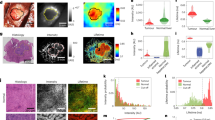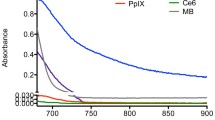Abstract
Several photosensitizers were screened for their tumour-marking ability using laserinduced fluorescence in Wistar/Furth rats bearing subcutaneous adenocarcinomas inoculated in muscle. Of the studied photosensitizers, dihaematoporphyrin ether appeared to exhibit the best tumour-demarcation properties. Polyhaematoporphyrin ester and tetrasulfonated phthalocyanine were almost as good although the fluorescence yield was much lower. Monomeric haematoporphyrin also showed some tumour-marking qualities. By forming fluorescence intensity ratios, information from both the blue and the red spectral regions were used to provide the highest tumour-to-muscle contrast. Two excitation wavelengths were used, of which 337 nm rather than 405 nm excitation light seemed to yield a better tumour demarcation, due to a greater difference in the superimposing autofluorescence between tumour and surrounding tissue. The study included measurements on many inner organs in an attempt to gain a better understanding of the interaction between the drugs and various kinds of tissue.
Similar content being viewed by others
References
Bown SG, Carruth JAS, Jori G, Svaasand LO (eds).Lasers Med Sci 1988, International conference on Photodynamic Therapy and Medical Applications, Abstract issue, July
Dougherty TJ, Grindey GB, Fiel R et al. Photoradiation therapy II. Cure of animal tumours with hematoporphyrin and light.J Natl Cancer Inst 1975,55:115–19
Dougherty TJ, Kaufman JE, Goldfarb et al. Photoradiation therapy and treatment of malignant tumors.Cancer Res 1978,38:2628–35
Dougherty TJ, Lawrence G, Kaufman J et al. Photoradiation in the treatment of recurrent breast carcinoma.J Natl Cancer Inst 1979,62:231–7
Gomer CJ, Dougherty TJ. Determination of [3H]- and [14C]-hematoporphyrin derivative distribution in malignant and normal tissue.Cancer Res 1979,39:146–51
Bugelski PJ, Porter CW, Dougherty TJ. Autoradiographic distribution of hematoporphyrin derivative in normal and tumor tissue of the mouse.Cancer Res 1981,41:4606–12
Dougherty TJ. Photoradiation therapy for cutaneous and subcutaneous malignancies.J Invest Dermatol 1981,77:122–4
Lipson RL, Baldes EJ. The photodynamic properties of a particular hematoporphyrin derivative.Arch Dermatol 1960,82:508–16
Moan J, Sommer S. Fluorescence and absorption properties of the components of hematoporphyrin derivative.Photobiochem Photobiophys 1981,3:93–103
Dougherty TJ, Boyle DG, Weishaupt KR et al. Photoradiation therapy: clinical and drug advances. In: Kessel D, Dougherty TJ (eds)Porphyrin Photosensitization. New York-London: Plenum 1983
Kessel D, Chou TH. Tumor localizing components of the porphyrin preparation hematoporphyrin derivative.Cancer Res 1983,43:1994–9
Cadby PA, Dimitriadis E, Forbes IJ. An analysis of hematoporphyrin derivative. In: Kessel D, Dougherty TJ (eds)Porphyrin Photosensitization. New York-London: Plenum 1983:251–63
Andreoni A, Cubeddu R. Fluorescence properties of HPD and its components. In: Andreoni A, Cubeddu R (eds)Porphyrins and Tumor Phototherapy. New York: Plenum 1984:11–21
Bonnett R, Berenbaum MC, Kaur H. Chemical and biological studies on hematoporphyrin derivative: an unexpected photosensitization of the brain. In: Andreoni A, Cubeddu R (eds)Porphyrins and Tumor Phototherapy. New York: Plenum 1984:67–80
Sun CH, Duzman E, Mellott J et al. Spectroscopic, morphologic and cytotoxic studies on major fractions of hematoporphyrin derivative and Photofrin II.Lasers Surg Med 1987,7:171–9
Rimington C, Sommer S, Moan J. Hematoporphyrin ethers—I. Generalized synthesis and chemical properties.Int J Biochem 1987,19:315–20
Dougherty TJ, Potter WR, Weishaupt KR. The structure of the active component of hematoporphyrin derivative. In: Andreoni A, Cubeddu R (eds)Porphyrins and Tumor Phototherapy. New York: Plenum 1984:23–35
Kessel D. In vivo fluorescence of tumors after treatment with derivatives of hematoporphyrin.Photochem Photobiol 1986,44:107–8
Moan J. Porphyrin photosensitization and phototherapy.Photochem Photobiol 1986,43:681–90
Lai JJ, McCaul BW, Smith KM, Straight RC. Polyhematoporphyrin esters: Preparation, properties and biological activity of a new stable derivative of hematoporphyrin for photodynamic therapy. In:Clayton Foundation Conference on Photodynamic Therapy. Los Angeles, CA 1987
Fioretti P, Faccini V, Gadducci A, Cozzani I. Monitoring of hematoporphyrin injected in humans and clinical prospects of its use in gynecologic oncology. In: Andreoni A, Cubeddu R (eds)Porphyrins and Tumor Phototherapy. New York: Plenum 1984, 355–61
Kessel D. Components of hematoporphyrin derivatives and their tumor-localizing capacity.Cancer Res 1982,42:1703–6
Ben Hur E, Rosental I. Photosensitized inactivation of Chinese hamster cells by Phthalocyanines.Photochem Photobiol 1985,42:129–33
Chan W-S, Marshall JF, Svensen R et al. Photosensing activity of phthalocyanine dyes screened against tissue culture cells.Photochem Photobiol 1987,45:757–61
Tralau CJ, MacRobert PD, Coleridge-Smith H et al. Photodynamic therapy with phthalocyanine sensitization: quantitative studies in a transplantable rat fibrocarcinoma.Br J Cancer 1987,55:389–95
Spikes JD. Phthalocyanines as photosensitizers in biological systems and for photodynamic therapy of tumors.Photochem Photobiol 1986,43:691–9
Andersson-Engels S, Ankerst J, Montan S et al. Aspects of tumour demarcation in rats by means of laser-induced fluorescence and hematoporphyrin derivatives.Lasers Med Sci 1988,3:239–48
Montan S, Svanberg K, Svanberg S. Multicolor imaging and contrast enhancement in cancer-tumor localization using laser-induced fluorescence in Hematoporphyrin-Derivative-bearing tissue.Optics Lett 1985,10:56–8
Svanberg K, Kjellén E, Ankerst J et al. Fluorescence studies of Hematoporphyrin Derivative in normal and malignant rat tissue.Cancer Res 1986,46:3803–8
Ankerst J, Montán S, Svanberg K, Svanberg S. Laser-induced fluorescence studies of hematoporphyrin derivative (HPD) in normal and malignant rat tissue.Appl Spectr 1984,38:890–6
Moan J, Sommer S. Uptake of the components of hematoporphyrin derivatives by cells and tumours.Cancer Lett 198321:167–76
Evensen JF, Sommer S, Moan J, Christensen T. Tumor-localizing and photosensitizing properties of the main components of hematoporphyrin derivative.Cancer Res 1984,44:482–6
Miyoshi N, Hisazumi H, Ueki O, Hakajima K. Cellular Binding of hematoporphyrin derivative in human bladder cancer cell lines: KK-47.Photochem Photobiol 1984,39:359–63
Author information
Authors and Affiliations
Rights and permissions
About this article
Cite this article
Andersson-Engels, S., Ankerst, J., Johansson, J. et al. Tumour marking properties of different haematoporphyrins and tetrasulfonated phthalocyanine—A comparison. Laser Med Sci 4, 115–123 (1989). https://doi.org/10.1007/BF02032608
Received:
Issue Date:
DOI: https://doi.org/10.1007/BF02032608




